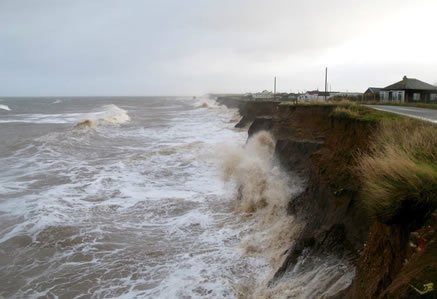Constructive waves
Find out more about constructive waves.
Destructive waves
Find out more about destructive waves.
Backwash
Find out more about waves.
The distance a wave has travelled.
Find out more about waves.
Fetch, wind speed and wind duration.
Find out more about waves.
Corrasion is when destructive waves pick up beach material (e.g. pebbles) and hurl them at the base of a cliff. Over time this can loosen cliff material forming a wave-cut notch.
Find out more about coastal erosion.
Waves hitting the base of a cliff causes leads to air compression in cracks, joints and folds in bedding planes, causing repeated changes in air pressure. As air rushes out of the crack when the wave retreats, it leads to an explosive effect as pressure is released. This process is supported further by the weakening effect of weathering. The material breaks off cliffs, sometimes in huge chunks. This process is known as hydraulic action.
Find out more about coastal erosion.
Corrasion, abrasion, hydraulic action, attrition and corrosion/solution.
Find out more about the processes of coastal erosion.
The wearing away of land by the sea.
Find out more about coastal erosion.
Corrosion/solution is when certain types of cliff erode as a result of weak acids in the sea.
Find out more about the processes of coastal erosion.
Recently weathered rock can be seen at the foot of chalk and limestone cliffs and is easily identified because it is angular.
Find out more about weathering.
Weathering is the breakdown of rock in situ by the action of rainwater, extremes of temperature, and biological activity.
Find out more about weathering.
Mechanical weathering is the breakdown of rock without changing its chemical structure (composition).
Find out more about weathering.
Freeze-thaw weathering occurs when rocks are porous (contain holes) or permeable (allow water to pass through). Water enters the rock and freezes. The ice expands by around 9%. This causes pressure on the rock until it cracks. Repeated freeze-thaw can cause the rock to break up.
Find out more about weathering.
When rainwater hits rock it decomposes it or eats it away. This is known as carbonation. This occurs when slightly acidic (carbonic) rain or seawater comes into contact with sedimentary rock, such as limestone or chalk, it causes it to dissolve. A chemical reaction occurs between the acidic water and the calcium carbonate and forms calcium bicarbonate. This is soluble and is carried away in solution. Carbonation weathering occurs in warm, wet conditions.
Find out more about weathering.
Beach material is suspended and carried by the waves.
Find out more about coastal tansportation.
Coastal transportation involves material being transported by the sea being deposited or dropped.
Find out more about coastal deposition.
Longshore drift
Find out more about longshore drift.
Solution, suspension, saltation and traction.
Find out more about coastal transportation.
Littoral drift
Find out more about longshore drift.

